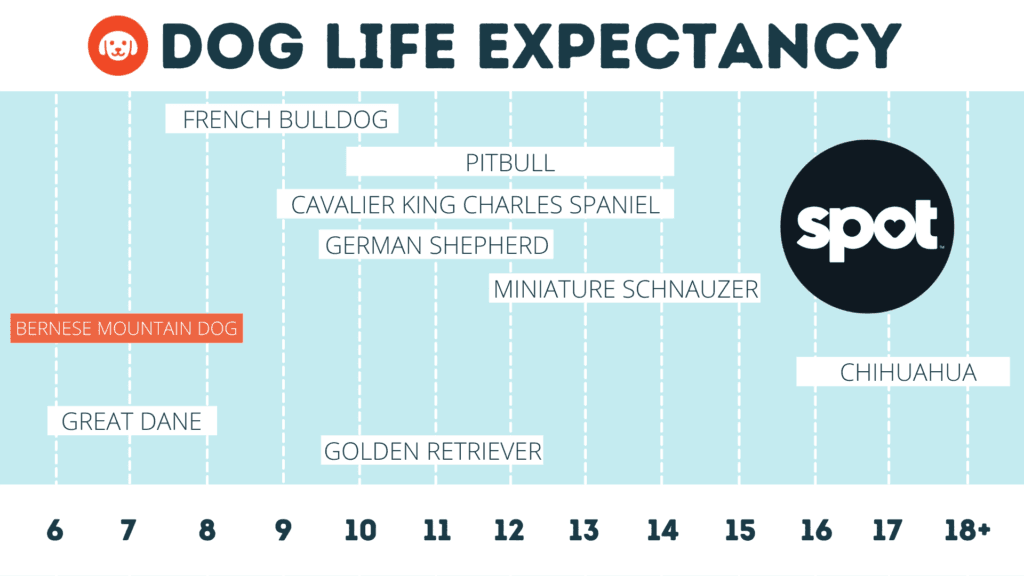Common Bernese Mountain Dog Health problems include:
Hip Dysplasia
Elbow Dysplasia
Progressive Retinal Atrophy (PRA)
Bloat
Histiocytosis
Von Willebrand's Disease
Bernese Mountain Dogs (German: Berner Sennenhund) are true family companions that are eager to please. In fact, it’s easy to put these good-natured, low-maintenance dogs squarely in the “great family dog” category. Bernese Mountain Dogs also do well with strangers and other pets, especially when their owners take time to make sure their dogs are well socialized.
Take a look at the following common health problems that afflict these pets, especially if you think you may want to adopt a Berner. On the other hand, if you already have a Bernese Mountain Dog and you want to make sure your dog has a long, healthy, and happy life, you may want to watch for signs of the following health problems.
Hip Dysplasia
Bernese Mountain Dogs are a giant breed, on average, weighing 80-115 pounds (male), 70-95 pounds (female). Large dogs in particular are at risk of canine hip dysplasia, which causes the head of the femur bone to join into the hip socket incorrectly. Berners may inherit canine hip dysplasia, or it may develop over time.
If you notice your dog suffering from pain or discomfort, lameness or stiff legs, it could signal hip dysplasia. You might also notice a strange gait when your dog runs, difficulty getting up from a laying down position or an unwillingness to chase or run.
Hip dysplasia in Bernese Mountain Dogs can be prevented by maintaining a healthy weight and by having regular hip joint evaluations at vet checkups to detect and minimize the severity of dysplasia. Treatment for this type of health issue may involve surgery.
There are special types of dog food that your vet may recommend to your large breed dog when they are a puppy to slow down their growth in order for their bones to not grow in excess, which may help prevent dysplasia in your pup. Your vet may recommend chewable tablets for your canine to prevent dysplasia, too.
Signs of hip dysplasia in dogs:
Decreased activity
Decreased range of motion
Lameness in the hind legs
Swaying, “bunny hopping” gait
Joint grating during movement
Thigh muscle mass loss
Stiffness and/or limping
Elbow Dysplasia
Elbow dysplasia, an inherited condition, involves malformation and degeneration of your Berner’s elbow joints.
If you notice that your dog experiences forelimb pain, a diminished range of motion, and a tendency to hold the forelimb away from the body, your dog may have elbow dysplasia.
Both hip and elbow dysplasia may be treated with medications, surgery, and dietary supplements by your veterinarian. Your veterinarian may suggest surgery to correct the affected joints.
Symptoms of Elbow Dysplasia:
Mild to moderate pain in front limbs
Front limb lameness
Arthritis development
Progressive Retinal Atrophy (PRA)
Bernese Mountain Dog eyes are also susceptible to Progressive Retinal Atrophy (PRA). PRA is an inherited eye condition in which the retina degenerates and the result means that dogs suffer impaired vision and often blindness. Berners can suffer from either early- or late-onset PRA:
Early-onset PRA: Veterinarians can detect abnormal cell development problems as early as 3 months old.
Late-onset PRA: Cells develop normally in late-onset PRA but degenerate later in life, causing vision problems in Berners aged three to five years old.
Berners may experience night blindness, dilated pupils and may not want to explore new places because they can’t see well.
Veterinarians cannot cure PRA, and dogs diagnosed with PRA typically go blind within 1 year. If you’re planning on bringing home a new dog, it is always a good idea to ask the breeder for certificates of annual eye examinations from the parent dogs by a veterinarian ophthalmologist. Your veterinarian can also order a DNA test to predict PRA in your Bernese Mountain Dog as an alternative.
Check for the following signs and symptoms in your Berner if they start behaving differently.
Symptoms of Bernese Mountain Dog eye infections and PRA:
Dilated pupils
Night blindness
Disorientation in new or familiar environments
Hesitancy to explore new places
Bloat
Bernese Mountain Dogs can become at risk for bloat and gastric torsion, which is also known as gastric dilatation and volvulus (GDV). This means the stomach twists on itself and fills with gas, cutting off blood supply to the stomach and sometimes the spleen. Bloat can result in death in as little as 30 minutes.
If your Berner tries to throw up (but nothing comes out), can’t relax, or tries lying down in a strange position (with front feet down and rear end up), your dog may have bloat.
If you see these symptoms, take your pet to your veterinarian or veterinary hospital immediately!
Symptoms of GDV and gastric dilatation in Berners:
Anxious behavior
Abdominal pain
Excessive drooling
Vomiting
Unproductive dry heaving
Your veterinarian may conduct x-ray exams of the abdomen and or complete a urinalysis to diagnose GDV or other possible infections.
Histiocytosis
You might imagine that a long, scary-sounding word like histiocytosis means cancer, and that’s exactly right. The most common form of cancer in Bernese Mountain Dogs, histiocytosis occurs in the dog’s histiocytes, a type of white blood cell. This type of cancer reproduces rapidly and invades tissues. Other breeds don’t usually carry histiocytosis, but histiocytosis occurs in approximately 25% of all breed cases.
Berners can carry either malignant or systemic histiocytosis. Look for lethargy, loss of appetite and weight loss to indicate histiocytosis. You may find that your dog experiences skin conditions with systemic histiocytosis.
Veterinarians cannot prescribe successful treatment for histiocytosis and sadly there is no cure. The malignant form usually leads to death in a matter of weeks. Systemic histiocytosis episodes come and go but eventually lead to death.
Signs and symptoms of Histiocytosis:
Skin lesions
Appetite loss
Lethargy
Weight loss
Von Willebrand’s Disease (vWD)
This common health condition in humans is also a common health issue with Bernese Mountain Dogs, too. It is caused by a deficiency in a required protein that allows blood platelets to stick together, clot, and form seals along broken blood vessels.
Veterinarians can quickly diagnose Von Willebrand’s disease with a DNA test. It can be detected at any age and is most commonly tested for after surgery or injury. In severe cases, symptoms may appear by the time the dog is 1 year of age.
Symptoms of vWD in dogs:
Frequent bloody noses
Spontaneous bleeding from gums or mouth
Prolonged bleeding after surgery or injury
Blood in stool or urine
Bruising
How Long Do Bernese Mountain Dogs Live?
Whether you have a Bernese Mountain Dog now or are thinking about adding one to the family, it’s helpful to know their average lifespan and what to expect. While it varies depending on things like lifestyle and extraordinary events, the average lifespan for a Berner is 7 – 10 years.

Health Outlook For Berners
Despite the health issues, these large, lovable dogs make great, healthy companions. While they have a shorter life expectancy than other, smaller breeds, they are loyal and charming dogs that will surely leave a paw-sitive impact on your family’s lives.
The best thing you can do for taking care of this large breed is to make sure they visit the vet regularly. Your vet will be able to conduct the appropriate tests and exams for potential health conditions your Berner may already have or carry, and provide a roadmap for how to best care for them.

Mostly a tech person, always a pet person. I am dedicated to improving the lives of pets and their humans with technology. Off-duty, I enjoy writing about the misbehaving of computer programs and my two Aussiedoodles, Calvin and Hobbes.












